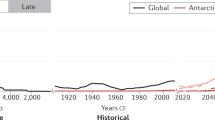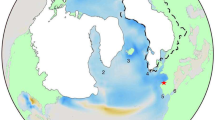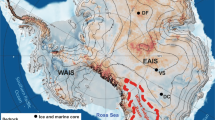Abstract
Antarctica’s continental-scale ice sheets have evolved over the past 50 million years1,2,3,4. However, the dearth of ice-proximal geological records5,6,7,8 limits our understanding of past East Antarctic Ice Sheet (EAIS) behaviour and thus our ability to evaluate its response to ongoing environmental change. The EAIS is marine-terminating and grounded below sea level within the Aurora subglacial basin, indicating that this catchment, which drains ice to the Sabrina Coast, may be sensitive to climate perturbations9,10,11. Here we show, using marine geological and geophysical data from the continental shelf seaward of the Aurora subglacial basin, that marine-terminating glaciers existed at the Sabrina Coast by the early to middle Eocene epoch. This finding implies the existence of substantial ice volume in the Aurora subglacial basin before continental-scale ice sheets were established about 34 million years ago1,2,3,4. Subsequently, ice advanced across and retreated from the Sabrina Coast continental shelf at least 11 times during the Oligocene and Miocene epochs. Tunnel valleys12 associated with half of these glaciations indicate that a surface-meltwater-rich sub-polar glacial system existed under climate conditions similar to those anticipated with continued anthropogenic warming10,11. Cooling since the late Miocene13 resulted in an expanded polar EAIS and a limited glacial response to Pliocene warmth in the Aurora subglacial basin catchment14,15,16. Geological records from the Sabrina Coast shelf indicate that, in addition to ocean temperature, atmospheric temperature and surface-derived meltwater influenced East Antarctic ice mass balance under warmer-than-present climate conditions. Our results imply a dynamic EAIS response with continued anthropogenic warming and suggest that the EAIS contribution to future global sea-level projections10,11,15,17 may be under-estimated.
This is a preview of subscription content, access via your institution
Access options
Access Nature and 54 other Nature Portfolio journals
Get Nature+, our best-value online-access subscription
$29.99 / 30 days
cancel any time
Subscribe to this journal
Receive 51 print issues and online access
$199.00 per year
only $3.90 per issue
Buy this article
- Purchase on Springer Link
- Instant access to full article PDF
Prices may be subject to local taxes which are calculated during checkout



Similar content being viewed by others
References
Kennett, J. P. Cenozoic evolution of Antarctic glaciation, the circum-Antarctic ocean, and their impact on global paleoceanography. J. Geophys. Res. 82, 3843–3860 (1977)
Coxall, H. K. et al. Rapid stepwise onset of Antarctic glaciation and deeper calcite compensation in the Pacific Ocean. Nature 433, 53–57 (2005)
Kominz, M. A. et al. Late Cretaceous to Miocene sea-level estimates from the New Jersey and Delaware coastal plain coreholes: an error analysis. Basin Res. 20, 211–226 (2008)
Mudelsee, M., Bickert, T., Lear, C. H. & Lohmann, G. Cenozoic climate changes: a review based on time series analysis of marine benthic δ18O records. Rev. Geophys. 52, 333–374 (2014)
Naish, T. R. et al. Orbitally induced oscillations in the East Antarctic ice sheet at the Oligocene/Miocene boundary. Nature 413, 719–723 (2001)
Naish, T. R. et al. Obliquity-paced Pliocene West Antarctic ice sheet oscillations. Nature 458, 322–328 (2009)
Cooper, A. K. et al. in Antarctic Climate Evolution. Developments in Earth and Environmental Sciences (eds Florindo, F. & Siegert, M. ) 115–228 (Elsevier, 2009)
Escutia, C ., Brinkhuis, H ., Klaus, A. & Expedition 318 Scientists. Wilkes Land Glacial History. Proc. Integrated Ocean Drilling Program 318, http://doi.org/10.2204/iodp.proc.318.2011 (Ocean Drilling Program Management International, 2011)
Fretwell, P. et al. Bedmap2: improved ice bed, surface and thickness datasets for Antarctica. Cryosphere 7, 375–393 (2013)
Golledge, N. R. et al. The multi-millennial Antarctic commitment to future sea-level rise. Nature 526, 421–425 (2015)
DeConto, R. M. & Pollard, D. Contribution of Antarctica to past and future sea-level rise. Nature 531, 591–597 (2016)
Kehew, A. E., Piotrowski, J. A. & Jørgensen, F. Tunnel valleys: concepts and controversies. Earth Sci. Rev. 113, 33–58 (2012)
Herbert, T. D. et al. Late Miocene global cooling and the rise of modern ecosystems. Nat. Geosci. 9, 843–847 (2016)
Cook, C. P. et al. Dynamic behavior of the East Antarctic ice sheet during Pliocene warmth. Nat. Geosci. 6, 765–769 (2013)
Aitken, A. R. A. et al. Repeated large-scale retreat and advance of Totten Glacier indicated by inland bed erosion. Nature 533, 385–389 (2016)
Rovere, A. et al. The Mid-Pliocene sea-level conundrum: glacial isostasy, eustacy, and dynamic topography. Earth Planet. Sci. Lett. 387, 27–33 (2014)
Masson-Delmotte, V. et al. in Climate Change 2013: The Physical Science Basis. Contribution of Working Group I to the Fifth Assessment Report of the Intergovernmental Panel on Climate Change (eds Stocker, T. F. et al.) 383–464 (Cambridge Univ. Press, 2013)
Anagnostou, E. et al. Changing atmospheric CO2 concentration was the primary driver of early Cenozoic climate. Nature 533, 380–384 (2016)
DeConto, R. M. & Pollard, D. Rapid Cenozoic glaciation of Antarctica induced by declining atmospheric CO2 . Nature 421, 245–249 (2003)
Pälike, H. et al. The heartbeat of the Oligocene climate system. Science 314, 1894–1898 (2006)
Liebrand, D. et al. Evolution of the early Antarctic ice ages. Proc. Natl Acad. Sci. USA 114, 3867–3872 (2017)
Scher, H. D., Bohaty, S. M., Smith, B. W. & Munn, G. H. Isotopic interrogation of a suspected late Eocene glaciation. Paleoceanography 29, 628–644 (2014)
Carter, A., Riley, T. R., Hillenbrand, C.-D. & Rittner, M. Widespread Antarctic glaciation during the late Eocene. Earth Planet. Sci. Lett. 458, 49–57 (2017)
Passchier, S., Ciarletta, D. J., Miriagos, T. E., Bijl, P. K. & Bohaty, S. M. An Antarctic stratigraphic record of stepwise ice growth through the Eocene-Oligocene transition. GSA Bull. 129, 318–330 (2017)
Golledge, N. R., Levy, R. H., McKay, R. M. & Naish, T. R. East Antarctic ice sheet most vulnerable to Weddell Sea warming. Geophys. Res. Lett. 44, 2343–2351 (2017)
Young, D. A. et al. A dynamic early East Antarctic Ice Sheet suggested by ice-covered fjord landscapes. Nature 474, 72–75 (2011)
Li, X., Rignot, E., Mouginot, J. & Scheuchl, B. Ice flow dynamics and mass loss of Totten Glacier, East Antarctica, from 1989 to 2015. Geophys. Res. Lett. 43, 6366–6373 (2016)
Rintoul, S. R. et al. Ocean heat drives rapid basal melt of the Totten Ice Shelf. Sci. Adv. 2, e1601610 (2016)
Wright, A. P. et al. Evidence of a hydrological connection between the ice divide and ice sheet margin in the Aurora Subglacial Basin, East Antarctica. J. Geophys. Res. 117, F01033 (2012)
Close, D. I., Stagg, H. M. J. & O’Brien, P. E. Seismic stratigraphy and sediment distribution on the Wilkes Land and Terre Adélie margins, East Antarctica. Mar. Geol. 239, 33–57 (2007)
Anderson, J. & Bartek, L. R. in The Antarctic Paleoenvironment: A Perspective on Global Change (eds Kennett, J. P. & Warnke, D. A. ) Antarctic Research Series Vol. 56, 213–263 (American Geophysical Union, 1992)
Ó Cofaigh, C. Tunnel valley genesis. Prog. Phys. Geogr. 20, 1–19 (1996)
Huuse, M. & Lykke-Andersen, H. Over-deepened Quaternary valleys in the eastern Danish North Sea: morphology and origin. Quat. Sci. Rev. 19, 1233–1253 (2000)
Denton, G. H. & Sugden, D. E. Meltwater features that suggest Miocene ice-sheet overriding of the Transantarctic Mountains in Victoria Land, Antarctica. Geograf. Ann. A 87, 67–85 (2005)
Lonergan, L., Maidment, S. & Collier, J. Pleistocene subglacial tunnel valleys in the central North Sea basin: 3-D morphology and evolution. J. Quat. Sci. 21, 891–903 (2006)
Elmore, C. R., Gulick, S. P. S., Willems, B. & Powell, R. Seismic stratigraphic evidence for glacial expanse during glacial maxima in the Yakutat Bay Region, Gulf of Alaska. Geochem. Geophys. Geosyst. 14, 1294–1311 (2013)
van der Vegt, P., Janszen, A. & Moscariello, A. Tunnel valleys: current knowledge and future perspectives. Geol. Soc. Lond. Spec. Publ. 368, 75–97 (2012)
Bjarnadóttir, L. R., Winsborrow, M. C. M. & Andreassen, K. Large subglacial meltwater features in the central Barents Sea. Geology 45, 159–162 (2017)
Piotrowski, J. A. Subglacial hydrology in north-western Germany during the last glaciation: groundwater flow, tunnel valleys and hydrologic cycles. Quat. Sci. Rev. 16, 169–185 (1997)
Bart, P. J. Were West Antarctic Ice Sheet grounding events in the Ross Sea a consequence of East Antarctic Ice Sheet expansion during the middle Miocene? Earth Planet. Sci. Lett. 216, 93–107 (2003)
Scherer, R. P. A new method for the determination of absolute abundance of diatom and other silt-sized sedimentary particles. J. Paleolimnol. 12, 171–179 (1994)
Crampton, J. S. et al. Southern Ocean phytoplankton turnover in response to stepwise Antarctic cooling over the past 15 million years. Proc. Natl Acad. Sci. USA 113, 6868–6873 (2016)
Contreras, L. et al. Southern high-latitude terrestrial climate change during the Paleocene–Eocene derived from a marine pollen record (ODP Site 1172, East Tasman Plateau). Clim. Past Discuss. 10, 291–340 (2014)
Partridge, A. D. Late Cretaceous-Cenozoic palynology zonations: Gippsland Basin. In Australian Mesozoic and Cenozoic Palynology Zonations (update to the 2004 Geologic Time Scale) (ed. Monteil, E. ) Geoscience Australia Record 2006/23 (2006)
MacPhail, M. K. & Truswell, E. M. Palynology of Site 1166, Prydz Bay, East Antarctica. Proc. ODP Sci. Res. 188, 1–43 (2004)
Truswell, E. M. & MacPhail, M. K. Fossil forests on the edge of extinction: what does the fossil spore and pollen evidence from East Antarctica say? Aust. Syst. Bot. 22, 57–106 (2009)
Raine, J. I ., Mildenhall, D. C & Kennedy, E. M. New Zealand Fossil Spores and Pollen: an Illustrated Catalogue 4th edn, http://data.gns.cri.nz/sporepollen/index.htm (GNS Science Miscellaneous Series 4, 2011)
Hill, R. S. (ed.) in History of the Australian Vegetation: Cretaceous to Recent 233 (Cambridge Univ. Press, 1994)
Truswell, E. M. Recycled Cretaceous and Tertiary pollen and spores in Antarctic marine sediments: a catalogue. Palaeontographica B 186, 121–174 (1983)
Pocknall, D. T. Late Eocene to early Miocene vegetation and climate history of New Zealand. J. R. Soc. N. Z. 19, 1–18 (1989)
Dettmann, M. E., Pocknall, D. T., Romero, E. J. & Zamalao, M. del C. Nothofagidites Erdtman ex Potonie, 1960; a catalogue of species with notes on the paleogeographic distribution of Nothofagus BI. (Southern Beech). N. Z. Geol. Surv. Paleo. Bull. 60, 1–79 (1990)
Stover, L. E . & Partridge, A. D. Tertiary and Late Cretaceous spores and pollen from the Gippsland Basin, southeastern Australia. Proc. R. Soc. Vic. 85, 237–286 (1973)
Stover, L. E. & Evans, P. R. Upper Cretaceous-Eocene spore-pollen zonation, offshore Gippsland Basin, Australia. Geol. Soc. Aust. Spec. Pub. 4, 55–72 (1973)
Harris, W. K. Basal Tertiary microfloras from the Princetown area, Victoria, Australia. Palaeontographica B 115, 75–106 (1965)
Couper, R. A. New Zealand Mesozoic and Cainozoic plant microfossils. N. Z. Geol. Surv. Paleo. Bull. 32, 1–87 (1960)
Raine, J. I. Outline of a palynological zonation of Cretaceous to Paleogene terrestrial sediments in west coast region, South Island, New Zealand. N. Z. Geol. Surv. Rep. 109, 1–82 (1984)
Greenwood, D. R., Moss, P. T., Rowett, A. I., Vadala, A. J. & Keefe, R. L. Plant communities and climate change in southeastern Australia during the early Paleogene. Geol. Soc. Spec. Pap. 369, 365–380 (2003)
Stover, L. E. & Partridge, A. D. Eocene spore-pollen from the Werillup Formation, Western Australia. Palynology 6, 69–96 (1982)
Thomas, E. Late Cretaceous through Neogene deep-sea benthic foraminifers (Maud Rise, Weddell Sea, Antarctica). Proc. ODP Sci. Res. 113, 571–594 (1990)
McGowran, B. Two Paleocene foraminiferal faunas from the Wangerrip Group, Pebble Point Coastal section, Western Victoria. Proc. R. Vict. 79, 9–74 (1965)
Brotzen, F. The Swedish Paleocene and its foraminiferal fauna. Arsb. Sver. Geol. Unders. 42, 1–140 (1948)
Holbourn, A ., Henderson, A . & MacLeod, N. Atlas of Benthic Foraminifera (Wiley-Blackwell, 2013)
Li, Q., James, N. P. & McGowran, B. Middle and late Eocene Great Australian Bight lithobiostratigraphy and stepwise evolution of the southern Australian continental margin. Aust. J. Earth Sci. 50, 113–128 (2003)
Tauxe, L. et al. Chronostratigraphic framework for the IODP Expedition 318 cores from the Wilkesland Margin: constraints for paleoceanographic reconstruction. Paleoceanography 27, PA2214 (2012)
Acknowledgements
We thank the NBP14-02 science party, the ECO captain and crew, and the ASC technical staff aboard the RV/IB N. B. Palmer. NBP14-02 was supported by the National Science Foundation (grants NSF PLR-1143836, PLR-1143837, PLR-1143843, PLR-1430550 and PLR-1048343) and a GSA graduate student research grant (to C.S.). We thank the Antarctic Marine Geology Research Facility staff at Florida State University for sampling assistance and E. Thomas, M. Katz, F. Sangiorni, P. Bijl and S. Manchester for discussions. This is UTIG Contribution #3137.
Author information
Authors and Affiliations
Contributions
S.P.S.G. and A.E.S. contributed equally to this work, co-writing the manuscript with input from all authors. D.D.B., S.P.S.G., A.L. and A.E.S. conceived the study. B.F., R.F., S.P.S.G., A.L., A.E.S., C.S. and the shipboard scientific party collected geophysical data and samples on USAP cruise NBP14-02. All authors contributed to the analyses and interpretation of the results.
Corresponding author
Ethics declarations
Competing interests
The authors declare no competing financial interests.
Additional information
Reviewer Information Nature thanks K. Billups, A. Bruch, S. Greenwood and the other anonymous reviewer(s) for their contribution to the peer review of this work.
Publisher's note: Springer Nature remains neutral with regard to jurisdictional claims in published maps and institutional affiliations.
Extended data figures and tables
Extended Data Figure 1 Uninterpreted NBP14-02 seismic profiles with line crossings and coring sites indicated.
a, Line 13 with piston core sites JPC-30 and JPC-31 and formation penetration depths indicated by red lines. b, Line 17 with core sites JPC-55 and JPC-54 and formation penetration depths indicated by red lines. c, Line 07 showing intersection with Line 10. d, Line 10 showing intersections with Line 07 and Line 21. e, Line 21 showing intersection with Line 10. CDP, common depth point.
Extended Data Figure 2 Site location and sedimentological, geochemical and palaeontological data from piston core NBP14-02 JPC-55 plotted versus depth.
a, Chirp record of JPC-55 site; location and penetration indicated (red line); site coordinates and multibeam depth (MB) included. b, Gastropod steinkern (70–72 cm below sea floor). c, Siderite concretion with monocot stem nucleus (118–125 cm below sea floor). d, Close-up of monocot stem. e, JPC-55 lithologic unit, photograph, X-ray radiograph, graphic lithology, coring disturbance, sedimentary structures, lithologic accessories (such as fossils and diagenetic features), sample locations, age, benthic foraminifers per 30 cm3 sediment, magnetic susceptibility (in SI units), gamma ray attenuation (GRA) bulk density (grams per cubic centimetre of sediment), bulk sediment δ13Corg (per mil; VPDB‰), and carbon/nitrogen (C/N) plotted versus depth in centimetres below sea floor (cmbsf; Supplementary Information).
Extended Data Figure 3 Site location and sedimentological and geochemical data from piston core NBP14-02 JPC-54 plotted versus depth.
a, JPC-54 lithologic unit, photograph, X-ray radiograph, graphic lithology, coring disturbance, sedimentary structures, lithologic accessories, sample locations, age, magnetic susceptibility (in SI units; Supplementary Information), GRA bulk density (grams per cubic centimetre of sediment), and bulk sediment δ13Corg (per mil; VPDB‰) plotted versus depth in centimetres below sea floor (cmbsf). b, Chirp record of JPC-54 site; location and penetration indicated (red line); site coordinates and multibeam depth included.
Extended Data Figure 4 Site location and sedimentological data from piston cores NBP14-02 JPC-30 and JPC-31 plotted versus depth.
a, Chirp record of JPC-30 site; location and penetration indicated (red line); site coordinates and multibeam depth included. b, JPC-30 lithologic unit, photograph, X-ray radiograph, graphic lithology, coring disturbance, sedimentary structures, lithologic accessories, sample locations, age, magnetic susceptibility (in SI units; see Supplementary Information), and GRA bulk density (grams per cubic centimetre of sediment) plotted versus depth in centimetres below sea floor (cmbsf). c, Chirp record of JPC-31 site; location, and penetration indicated (red line). d, JPC-31 lithology, age and physical properties as above.
Extended Data Figure 5 Benthic foraminifers from piston core NBP14-02 JPC-55
. a, Hoeglundina elegans (sample depth 76–78 cm below sea floor). b, SEM image of Hoeglundina elegans (76–78 cm below sea floor). c, Ceratobulimina sp. (70–72 cm below sea floor). d, Ceratobulimina sp. (70–72 cm below sea floor). e, SEM of Ceratobulimina sp. (70–72 cm below sea floor). f, SEM image of Gyroidinoides globosus (110–113 cm below sea floor). g, SEM image of Gyroidinoides globosus (110–113 cm below sea floor). h, Gyroidinoides globosus with pyrite (136–138 cm below sea floor). i, Gyroidinoides globosus with zoom-in of umbilicus on the right; pyrite is visible on the lower right side of the test (136–138 cm below sea floor). j, Palmula sp. (136–138 cm below sea floor; test >450 μm).
Extended Data Figure 6 Siliceous microfossils from piston core NBP14-02 JPC-31 diatomite sample.
a, Thalassiosira torokina. b, Thalassiosira oliverana var. sparsa. c, Actinocyclus ingens var. ovalis. d, Coscinodiscus marginatus. e, Azpeitia sp. 1. f, Actinocyclus sp. g, Actinocyclus sp. h, Shionodiscus tetraoestrupii. i, Shionodiscus tetraoestrupii. j, Shionodiscus oestrupii. k, Denticulopsis delicate. l, Denticulopsis simonsenii/D. vulgaris. m, Denticulopsis simonsenii/D. vulgaris. n, Denticulopsis delicate. o, Denticulopsis simonsenii/D. vulgaris. p, Rouxia naviculoides. q, Fragilariopsis praecurta. r, Fragilariopsis sp. 1. s, Trinacria excavate. t, Rhizosolenia hebetate. u, Eucampia antarctica var. recta. v, Distephanus speculum speculum f. varians. Sample taken from 43–45 cm below sea floor.
Supplementary information
Supplementary Data
This file contains Supplementary Data for sediment cores NBP14-02 JPC-30, -31, -54, and -55. The data file contains all sedimentary data plotted in Extended Data Figures 2-4. Physical properties data for JPC-30, -31, -54, and -55 are in four separate worksheets, listed by core ID. Bulk organic geochemical data from JPC-54 and -55 are in two separate worksheets, listed by core ID. (XLSX 30 kb)
Rights and permissions
About this article
Cite this article
Gulick, S., Shevenell, A., Montelli, A. et al. Initiation and long-term instability of the East Antarctic Ice Sheet. Nature 552, 225–229 (2017). https://doi.org/10.1038/nature25026
Received:
Accepted:
Published:
Issue Date:
DOI: https://doi.org/10.1038/nature25026
This article is cited by
-
An ancient river landscape preserved beneath the East Antarctic Ice Sheet
Nature Communications (2023)
-
On-shelf circulation of warm water toward the Totten Ice Shelf in East Antarctica
Nature Communications (2023)
-
Late Miocene onset of hyper-aridity in East Antarctica indicated by meteoric beryllium-10 in permafrost
Nature Geoscience (2023)
-
Response of the East Antarctic Ice Sheet to past and future climate change
Nature (2022)
-
Southern Ocean biogenic blooms freezing-in Oligocene colder climates
Nature Communications (2022)
Comments
By submitting a comment you agree to abide by our Terms and Community Guidelines. If you find something abusive or that does not comply with our terms or guidelines please flag it as inappropriate.



